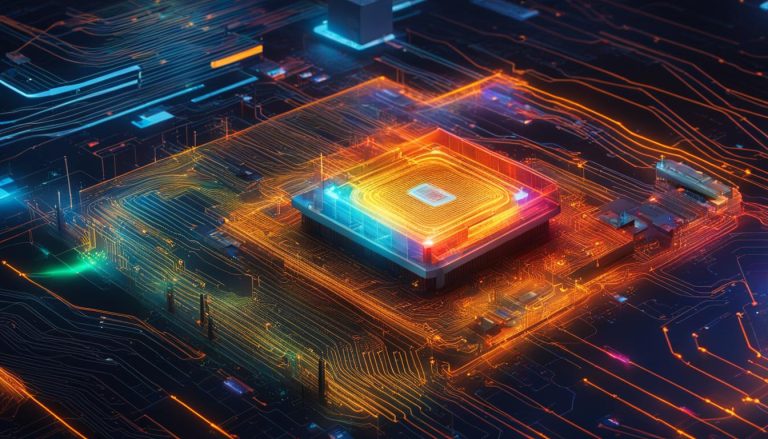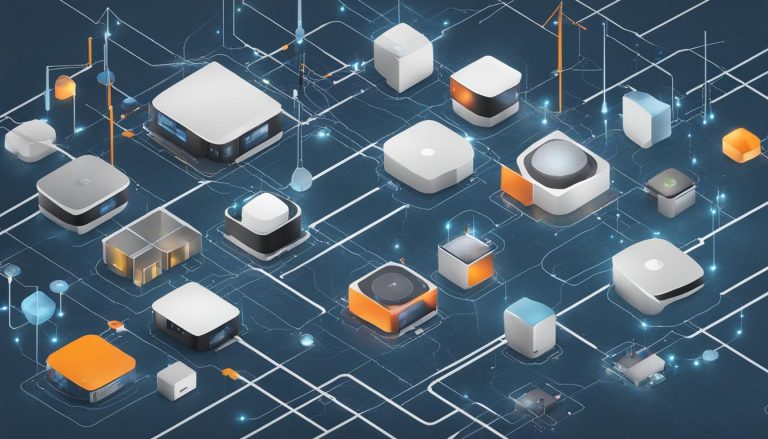Welcome to this comprehensive guide where I will walk you through everything you need to know about device drivers. In today’s digital age, we rely heavily on hardware components and peripherals attached to our computers to perform various tasks. But have you ever wondered how these devices seamlessly communicate with the operating system? The answer lies in device drivers.
Device drivers are the unsung heroes of our computer systems. They are software programs that act as a bridge between the operating system and the hardware, enabling smooth communication and control. Without device drivers, our printers wouldn’t print, our keyboards wouldn’t type, and our speakers wouldn’t produce sound.
Key Takeaways:
- Device drivers are software programs that allow hardware components to communicate with the operating system.
- They act as a bridge, enabling smooth communication and control between the hardware and software.
- There are different types of device drivers, including kernel device drivers, user-mode device drivers, character drivers, block drivers, and virtual drivers.
- Device drivers are crucial for optimizing system performance and ensuring hardware compatibility.
- Installing and updating the correct device drivers enhance overall computing experience.
What Is a Device Driver?
A device driver is a specialized software program that operates a specific computer-connected device. It provides a software interface for the hardware, allowing the operating system and other applications to access and control the device’s functionalities. Device drivers interact with the hardware through the computer bus or communication subsystem. They handle requests from the kernel and deliver device responses and messages to the computer.
Device drivers play a crucial role in enabling the seamless communication and functionality between hardware and software. They act as translators, ensuring that the operating system can understand and utilize the capabilities of the connected devices. The functions of device drivers include device initialization, managing data transfer, handling interrupts, and providing an interface for applications to interact with the hardware.
The device driver interface allows the operating system and applications to send commands and receive status information from the device. It facilitates the control and configuration of the device, enabling the system to perform tasks such as reading from or writing to storage devices, sending data to a printer, or playing audio through speakers. Device drivers also handle error detection and recovery, ensuring the stability and reliability of the system.
Device drivers act as a crucial link between the physical hardware and the software running on a computer system. They enable the operating system and applications to communicate with and control the connected devices, ensuring optimal performance and functionality.
Device Driver Communication
Device drivers establish communication with the operating system through various methods, depending on the hardware architecture and the operating system’s design. Common communication mechanisms include:
- Interrupts: Device drivers use interrupts to signal the operating system when a specific event or condition occurs. These events can include receiving data from the device, completing a data transfer, or reporting an error. Interrupt handlers in the device driver handle these events and execute the necessary actions.
- Direct Memory Access (DMA): DMA allows devices to transfer data directly to and from memory without involving the central processing unit (CPU). Device drivers set up and control DMA channels, enabling efficient data transfer between the device and memory, reducing CPU overhead.
- I/O Ports: Device drivers communicate with certain devices using input/output (I/O) ports. These ports allow the device driver to read and write data directly to and from the device. The device driver maps the physical I/O ports to memory addresses, making it accessible to the operating system and applications.
- Memory-Mapped I/O: In memory-mapped I/O, device drivers map the device’s control registers and data buffers to specific memory addresses. This allows the operating system and applications to read from and write to these memory locations, effectively communicating with the device.
By utilizing these communication mechanisms, device drivers ensure efficient and reliable data exchange between the hardware and software components of a computer system.
How Device Drivers Function
A device driver operates within the operating system kernel layer and functions as a vital component for accessing and controlling hardware operations. It plays a crucial role in facilitating the interface between the operating system and the hardware it is designed for. The functioning of a device driver involves receiving instructions from the operating system, executing device instructions, and transmitting device output or messages back to the OS. Without device drivers, devices like printers, speakers, and keyboards would not be able to function properly.
Device drivers have direct communication with the operating system, allowing them to perform essential tasks such as hardware initialization, data transfer, and hardware control. By operating within the kernel layer, device drivers have high-level privileges, enabling them to access and manipulate hardware components. This interaction between device drivers and the operating system forms the foundation for the smooth operation of hardware devices.
“Device drivers are the essential link that enables seamless communication and control between the operating system and hardware components.”
Key Points:
- Device drivers operate within the operating system kernel layer.
- They receive instructions from the operating system and execute device instructions.
- Device drivers enable hardware initialization and facilitate data transfer.
- They have high-level privileges to access and control hardware components.
Table: Examples of Device Driver Functions
| Device | Function |
|---|---|
| Printer | Enables communication between the computer and the printer, allowing printing operations. |
| Speaker | Converts data into audio signals for music playback. |
| Keyboard | Facilitates input of characters and commands into the computer system. |
Understanding Device Driver Development
Developing device drivers involves a meticulous process that requires in-depth hardware knowledge and expertise. To create a functional and efficient device driver, developers must possess a comprehensive understanding of the hardware platform they are working on. This includes familiarity with the hardware’s bus interface, device driver software location, and data transfer methods.
Once developers have a solid grasp of the hardware, they can begin the driver code writing process. This involves creating the kernel mode driver code, which includes essential functions such as load/unload functions and hardware initialization. The code must be carefully structured to ensure optimal performance and compatibility.
Hardware initialization is a critical aspect of device driver development. It involves configuring the hardware components and preparing them for operation. Developers must ensure that the driver effectively communicates with the hardware, allowing for seamless interaction between the operating system and the device.
Furthermore, device driver development also entails hardware control. Different devices have unique functionalities, and developers must implement the necessary mechanisms to control and manage these functionalities effectively. This involves handling hardware interrupts, managing data transfers, and providing the necessary abstractions for applications to interact with the hardware.
| Development Process | Hardware Knowledge | Driver Code Writing | Hardware Initialization | Hardware Control |
|---|---|---|---|---|
| 1. Understand the hardware platform | 1. Know the bus interface | 1. Write kernel mode driver code | 1. Configure hardware components | 1. Handle hardware interrupts |
| 2. Identify driver requirements | 2. Locate device driver software | 2. Implement load/unload functions | 2. Prepare hardware for operation | 2. Manage data transfers |
| 3. Design driver structure | 3. Understand data transfer methods | 3. Initialize hardware interactions | 3. Establish communication with OS | 3. Provide abstractions for applications |
Types of Device Drivers
Device drivers can be classified into different types based on their functionality and operation. Understanding these different types is crucial for developers and users alike, as each type serves a specific purpose and has its own set of characteristics and requirements.
Kernel Device Drivers
Kernel device drivers are essential components of the operating system. They are loaded during the boot process and handle critical hardware components necessary for the system’s basic functionality. Kernel device drivers have direct access to the hardware and operate in privileged mode, allowing them to efficiently manage and control hardware resources. Examples of kernel device drivers include drivers for the motherboard, processor, memory, and storage devices.
User-Mode Device Drivers
User-mode device drivers, also known as external or plug-and-play drivers, are triggered by users when connecting new devices to their systems. These drivers facilitate the communication between the operating system and external devices, allowing users to use the devices seamlessly. User-mode device drivers provide an additional layer of abstraction between the hardware and the operating system, simplifying the installation and configuration process. Common examples of user-mode device drivers include those for printers, scanners, USB devices, and external storage drives.
Character Drivers
Character drivers provide unstructured access to hardware devices, treating them as a stream of characters. They are responsible for handling input and output operations on devices that operate in a sequential or serial manner, such as keyboards, mice, serial ports, and terminals. Character drivers communicate with the hardware using simple read and write operations, without any complex data structures or buffering mechanisms.
Block Drivers
Block drivers, also known as block device drivers, provide structured access to hardware devices using file system block-sized buffers. They handle storage devices, such as hard drives and solid-state drives, which store data in fixed-size blocks. Block drivers offer more advanced functionalities compared to character drivers, including caching, buffering, and error handling. They manage the data transfer between the operating system and storage devices, ensuring efficient and reliable storage operations.
Virtual Drivers
Virtual drivers are software components that simulate the behavior of physical hardware devices. They are commonly used in virtualization environments, where multiple operating systems run concurrently on the same physical machine. Virtual drivers create virtual devices that are visible to the guest operating systems, allowing them to interact with the virtualized hardware. These drivers handle the translation of instructions and data between the guest operating systems and the underlying hypervisor or virtualization layer.
Understanding the different types of device drivers is essential for developers, as it helps them choose the appropriate driver model for their hardware and system requirements. For users, knowing the types of drivers enables them to troubleshoot issues, ensure compatibility, and make informed decisions when installing and updating drivers.
Importance of Device Drivers
Device drivers play a significant role in the overall performance and functionality of a computer system. These software programs are crucial for enabling hardware components to work smoothly and ensuring compatibility between the hardware and the operating system. Without the appropriate device drivers, hardware devices may not function correctly or at their full potential.
One of the key benefits of device drivers is optimizing system performance. By facilitating efficient communication and control between the operating system and hardware, device drivers ensure smooth data flow and minimize latency. This optimization leads to faster and more responsive operations, enhancing the overall user experience.
Another vital aspect of device drivers is ensuring hardware compatibility. Different hardware components have their own unique specifications and communication protocols. Device drivers act as translators, allowing the operating system to understand and interact with various hardware devices. They bridge the gap between hardware and software, enabling seamless integration and communication.
“Device drivers play a crucial role in the overall performance and functionality of a computer system.”
Moreover, device drivers enable the utilization of advanced features and functionalities of hardware devices. For example, a sound card device driver provides the necessary software interface for playing high-quality audio and controlling sound settings. Similarly, a graphics card device driver unlocks the full potential of a GPU, enabling complex visual rendering and 3D acceleration.
Overall, device drivers are essential for maintaining the smooth operation of a computer system. They ensure efficient communication, optimize performance, and enable hardware compatibility. As technology advances and new hardware components emerge, keeping device drivers up to date becomes even more crucial to leverage the full capabilities of the hardware and enhance the overall computing experience.
Applications of Device Drivers
Device drivers are crucial components in various types of devices, facilitating seamless communication and interaction between hardware components and a computer system. Let’s explore some of the key applications of device drivers in different devices:
Device Drivers in Printers
Printers are essential peripherals used for creating hard copies of digital documents. Device drivers specifically designed for printers enable the computer to communicate with the printer and control the printing operations. These drivers provide the necessary instructions and configurations to ensure accurate printing quality and support various printing features.
Device Drivers in Sound Cards
Sound cards are responsible for processing and producing audio signals for music playback, gaming, and multimedia applications. Device drivers for sound cards ensure the proper functioning of these audio devices by translating data into audio signals that can be played through speakers or headphones. These drivers enable users to adjust sound settings, enhance audio quality, and support different audio formats.
Device Drivers in Network Cards
Network cards, also known as network adapters or Ethernet cards, enable computers to connect to a network and access the internet or other network resources. Device drivers for network cards facilitate the communication between the operating system and the network card, allowing the computer to send and receive data over the network. These drivers ensure stable network connectivity, optimize data transmission, and provide configuration options for network settings.
Device Drivers in Modems
Modems are devices used for connecting computers to the internet via a telephone line, cable connection, or wireless network. Device drivers for modems enable the computer to communicate with the modem and establish internet connectivity by translating signals between the computer and the modem. These drivers ensure proper modem operation, support different connection protocols, and provide configuration options for internet settings.
Overall, device drivers play a vital role in various types of devices, enabling seamless integration and effective functioning with computer systems. By understanding the applications of device drivers in printers, sound cards, network cards, and modems, users can appreciate the importance of these drivers in enhancing device performance and ensuring smooth operations.
| Device | Application |
|---|---|
| Printers | Translation of data into printable format, control of printing operations |
| Sound cards | Processing and production of audio signals for music playback |
| Network cards | Facilitating communication between computers and networks |
| Modems | Establishing internet connectivity through various connection methods |
Conclusion
Device drivers are crucial components of a computer system that enable proper functioning and communication between hardware devices and the operating system. By serving as a bridge between the two, device drivers ensure that hardware devices like printers, sound cards, network cards, and modems can be effectively controlled and accessed.
The importance of device drivers cannot be overstated, as they optimize system performance and ensure hardware compatibility. Without the correct device drivers, hardware devices may not work correctly or at their full capacity, leading to decreased functionality and overall computing experience. It is essential to install and regularly update the appropriate device drivers to enhance the system’s performance and compatibility.
In summary, device drivers play a vital role in the seamless operation of computer systems. They provide the necessary interface and functionality for hardware components to work effectively with the operating system. Understanding the different types of device drivers and their applications is key to optimizing system performance and ensuring hardware compatibility. So, remember to always prioritize the installation and maintenance of the correct device drivers to enhance your overall computing experience.
FAQ
What is a device driver?
A device driver is a specialized software program that operates a specific computer-connected device, providing a software interface for the hardware and allowing the operating system and other applications to access and control the device’s functionalities.
How do device drivers function?
Device drivers interact with the hardware through the computer bus or communication subsystem. They handle requests from the kernel and deliver device responses and messages to the computer.
What is involved in device driver development?
Developing device drivers requires a deep understanding of the hardware platform. Developers need to know the hardware’s bus interface, device driver software location, and data transfer methods. They write the kernel mode driver code, including load/unload functions and hardware initialization.
What are the types of device drivers?
Device drivers can be classified into different types based on their functionality and operation. Some common types include kernel device drivers, user-mode device drivers, character drivers, block drivers, and virtual drivers.
Why are device drivers important?
Device drivers play a crucial role in the overall performance and functionality of a computer system. They enable hardware components to work properly and ensure compatibility between the hardware and the operating system, optimizing system performance by facilitating efficient communication and control.
How are device drivers used in different devices?
Device drivers have various applications in different types of devices. For example, printer device drivers enable communication between the computer and the printer, sound card device drivers convert data into audio signals for music playback, and network card device drivers facilitate network connectivity and communication.
Jana is a public relations specialist and writes about all kinds of software products that make our life easier.


